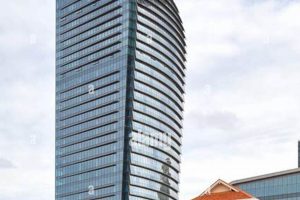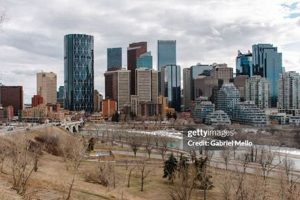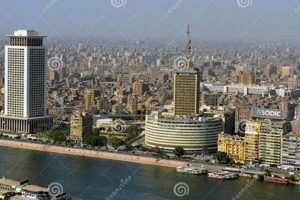Skyscrapers are among the most iconic structures in the world. They are towering buildings that dominate skylines and house a variety of businesses, offices, and residential units. But how big is a skyscraper? There is no one answer to this question, as skyscrapers come in all shapes and sizes. However, there are some general characteristics that most skyscrapers share.
First, skyscrapers are typically very tall. The Council on Tall Buildings and Urban Habitat (CTBUH) defines a skyscraper as a building that is at least 150 meters (492 feet) tall. However, many skyscrapers are much taller than this. For example, the Burj Khalifa in Dubai is over 828 meters (2,717 feet) tall. Skyscrapers are also typically very wide, with a large footprint that can accommodate a variety of uses. This allows them to house a large number of people and businesses.
Skyscrapers are often built in urban areas, where land is scarce and expensive. They allow for a more efficient use of space, as they can accommodate a large number of people and businesses in a relatively small area. Skyscrapers are also often built in areas that are prone to natural disasters, such as earthquakes and hurricanes. This is because they are designed to withstand high winds and seismic activity.
1. Height
The height of a skyscraper is one of its most defining characteristics. Skyscrapers are designed to be tall in order to maximize their use of space. The taller a skyscraper is, the more people and businesses it can accommodate. Additionally, the height of a skyscraper can be a status symbol, representing the power and prestige of the owner or developer.
There are a number of factors that affect the height of a skyscraper. These factors include the availability of land, the cost of construction, and the local building codes. In some cities, there are height restrictions that limit the height of buildings. However, in other cities, there are no such restrictions, and skyscrapers can be built to any height.
The height of a skyscraper can have a number of practical implications. For example, taller skyscrapers require more elevators and other infrastructure. Additionally, taller skyscrapers can be more difficult to evacuate in the event of a fire or other emergency. However, the height of a skyscraper can also provide a number of benefits. For example, taller skyscrapers offer more panoramic views and can be more energy-efficient.
In conclusion, the height of a skyscraper is an important factor to consider when designing and constructing a building. The height of a skyscraper can affect its use of space, its status, and its practical implications.
2. Width
The width of a skyscraper is another important factor to consider when designing and constructing a building. The width of a skyscraper affects its use of space, its structural integrity, and its overall appearance.
Skyscrapers are typically very wide in order to maximize their use of space. The wider a skyscraper is, the more people and businesses it can accommodate. Additionally, the width of a skyscraper can affect its structural integrity. A wider skyscraper is more stable and less likely to collapse in the event of an earthquake or other natural disaster.
The width of a skyscraper can also affect its overall appearance. A wider skyscraper can appear more imposing and impressive. Additionally, a wider skyscraper can be more energy-efficient, as it can be designed to capture more natural light.
In conclusion, the width of a skyscraper is an important factor to consider when designing and constructing a building. The width of a skyscraper affects its use of space, its structural integrity, and its overall appearance.
3. Location
The location of a skyscraper is an important factor in determining its size. Skyscrapers are often built in urban areas, where land is scarce and expensive. This is because urban areas offer a number of advantages for skyscrapers, including access to transportation, a large workforce, and a high concentration of businesses and customers.
- Land scarcity: In urban areas, land is often scarce and expensive. This is because urban areas are home to a large number of people and businesses, which drives up the demand for land. As a result, skyscrapers are often built in urban areas in order to maximize the use of space.
- Access to transportation: Urban areas are typically well-connected by public transportation, which makes it easy for people to get to and from skyscrapers. This is important for skyscrapers, which often house a large number of people and businesses.
- Large workforce: Urban areas have a large workforce, which makes it easy for skyscrapers to find employees. This is important for skyscrapers, which often require a large number of workers to operate.
- High concentration of businesses and customers: Urban areas have a high concentration of businesses and customers. This is important for skyscrapers, which often house a variety of businesses and attract a large number of customers.
In conclusion, the location of a skyscraper is an important factor in determining its size. Skyscrapers are often built in urban areas, where land is scarce and expensive, in order to take advantage of the benefits that urban areas offer.
4. Space efficiency
Skyscrapers are designed to be space-efficient, as they can accommodate a large number of people and businesses in a relatively small area. This is important in urban areas, where land is scarce and expensive. Skyscrapers can also be more energy-efficient than other types of buildings, as they can be designed to capture more natural light and to reduce heat loss.
- Vertical space utilization: Skyscrapers make use of vertical space, which allows them to accommodate a large number of people and businesses in a relatively small area. This is in contrast to single-story buildings, which can only accommodate a limited number of people and businesses in a given area.
- Mixed-use development: Skyscrapers often house a variety of uses, such as offices, residential units, and retail space. This allows for a more efficient use of space, as it eliminates the need for separate buildings for each use.
- Efficient infrastructure: Skyscrapers are designed with efficient infrastructure, such as elevators and escalators, which allow people to move around the building quickly and easily. This helps to
reduce congestion and wasted space. - Natural light and ventilation: Skyscrapers are often designed to capture natural light and ventilation, which can help to reduce energy costs and improve the indoor environment for occupants.
In conclusion, skyscrapers are designed to be space-efficient, as they can accommodate a large number of people and businesses in a relatively small area. This is important in urban areas, where land is scarce and expensive. Skyscrapers can also be more energy-efficient than other types of buildings, as they can be designed to capture more natural light and to reduce heat loss.
5. Natural disaster resistance
Skyscrapers are often built in areas that are prone to natural disasters, such as earthquakes and hurricanes. This is because they are designed to withstand high winds and seismic activity. The size of a skyscraper can play a role in its ability to withstand natural disasters. Taller skyscrapers are more likely to be equipped with advanced safety features, such as seismic dampers and wind turbines. Additionally, the materials used to construct a skyscraper can also affect its ability to withstand natural disasters. For example, skyscrapers that are built with reinforced concrete are more likely to be able to withstand earthquakes than skyscrapers that are built with steel.
- Structural design: Skyscrapers are designed with a strong structural system that can withstand high winds and seismic activity. This includes using reinforced concrete, steel, and other materials that are known for their strength and durability.
- Seismic dampers: Skyscrapers are often equipped with seismic dampers, which are devices that help to reduce the amount of vibration that is caused by earthquakes. This helps to protect the building from damage.
- Wind turbines: Skyscrapers are sometimes equipped with wind turbines, which can help to generate electricity and reduce the building’s reliance on fossil fuels. Wind turbines can also help to reduce the amount of wind that is able to reach the building, which can help to protect the building from damage.
- Fire safety: Skyscrapers are also designed with fire safety features, such as sprinkler systems and fire escapes. This helps to protect the building from damage in the event of a fire.
The size of a skyscraper can also affect its ability to withstand natural disasters. Taller skyscrapers are more likely to be equipped with advanced safety features, such as seismic dampers and wind turbines. Additionally, the materials used to construct a skyscraper can also affect its ability to withstand natural disasters. For example, skyscrapers that are built with reinforced concrete are more likely to be able to withstand earthquakes than skyscrapers that are built with steel.
6. Architectural innovation
Architectural innovation is a key component of skyscraper design, and it has a significant impact on the size of skyscrapers. Innovative architectural features can allow skyscrapers to be built taller and more efficiently, and they can also make skyscrapers more sustainable and environmentally friendly.
One of the most common innovative architectural features in skyscrapers is the glass facade. Glass facades allow for more natural light to enter the building, which can reduce the need for artificial lighting. Glass facades can also help to reduce heat gain in the building, which can save energy and make the building more comfortable for occupants. Additionally, glass facades can provide stunning views of the surrounding cityscape.
Another innovative architectural feature that is becoming increasingly common in skyscrapers is the green roof. Green roofs are roofs that are covered in vegetation. Green roofs can help to insulate the building, which can reduce energy costs. Green roofs can also help to improve air quality and reduce stormwater runoff.
Wind turbines are another innovative architectural feature that can be used to make skyscrapers more sustainable. Wind turbines can generate electricity, which can help to reduce the building’s reliance on fossil fuels. Wind turbines can also help to reduce wind loads on the building, which can make the building more resistant to damage from high winds.
The use of innovative architectural features can have a significant impact on the size of skyscrapers. By using innovative architectural features, architects can design skyscrapers that are taller, more efficient, and more sustainable.
7. Cultural significance
The cultural significance of skyscrapers is closely tied to their size. Skyscrapers are often the tallest buildings in a city, and they can be seen from miles around. This makes them iconic landmarks that are easily recognizable and associated with the city. For example, the Empire State Building is one of the most iconic landmarks in New York City, and it is known all over the world. The Petronas Towers are another example of iconic skyscrapers that are closely associated with the city of Kuala Lumpur.
The size of a skyscraper can also affect its cultural significance. Taller skyscrapers are more likely to be seen as landmarks and symbols of a city. For example, the Burj Khalifa is the tallest building in the world, and it is one of the most recognizable landmarks in the world. The size of the Burj Khalifa makes it a symbol of Dubai and its ambition to be a global city.
The cultural significance of skyscrapers can have a number of practical implications. For example, iconic skyscrapers can be used to attract tourists and businesses to a city. They can also be used to create a sense of place and identity for a city. Additionally, iconic skyscrapers can be used to promote a city’s image and brand.
In conclusion, the cultural significance of skyscrapers is closely tied to their size. Taller skyscrapers are more likely to be seen as landmarks and symbols of a city. The cultural significance of skyscrapers can have a number of practical implications, such as attracting tourists and businesses to a city.
FAQs on Skyscraper Dimensions
Skyscrapers, with their towering heights and imposing presence, have become defining features of modern skylines. Their size and grandeur often raise questions about their dimensions and characteristics. Here are answers to some frequently asked questions about skyscraper sizes:
Question 1: What is the minimum height for a building to be considered a skyscraper?
According to the Council on Tall Buildings and Urban Habitat (CTBUH), a skyscraper is a building that stands at least 150 meters (492 feet) tall.
Question 2: What is the tallest skyscraper in the world, and how tall is it?
As of 2023, the Burj Khalifa in Dubai holds the title of the tallest skyscraper in the world, standing at an impressive 828 meters (2,717 feet) tall.
Question 3: How wide are skyscrapers typically?
The width of skyscrapers can vary depending on their design and purpose. However, many skyscrapers have a large foo
tprint to accommodate a variety of uses, such as offices, residential units, and retail spaces.
Question 4: Are there any height limits for skyscrapers?
Building height limits are often imposed by local building codes and aviation regulations. These limits vary from city to city, with some having no restrictions while others have height caps to ensure airspace safety and urban planning considerations.
Question 5: How do skyscrapers withstand high winds and seismic activity?
Skyscrapers are engineered to withstand extreme weather conditions and seismic forces. They employ structural systems, wind-resistant designs, and materials like reinforced concrete and steel to ensure stability and safety.
Question 6: What are the key factors that determine the height of a skyscraper?
Several factors influence skyscraper height, including land availability, construction costs, building codes, and architectural innovations. Technological advancements in construction techniques and materials have pushed the boundaries of skyscraper heights.
In conclusion, skyscrapers are diverse in size and design, ranging from the minimum height of 150 meters to the towering heights of supertall structures like the Burj Khalifa. Their dimensions are shaped by a combination of architectural innovation, engineering prowess, and the demands of urban environments.
Tips for Understanding Skyscraper Dimensions
Skyscrapers, with their towering heights and impressive scale, can be difficult to fully grasp in terms of size. Here are a few tips to help you better understand skyscraper dimensions:
Tip 1: Use familiar objects for comparison.
Compare a skyscraper’s height to objects you’re familiar with, such as a football field (approximately 100 yards long) or a school building (typically around 2-3 stories tall). This can give you a more tangible sense of the skyscraper’s size.
Tip 2: Look at the building in different perspectives.
Observe the skyscraper from different angles and distances. This will help you appreciate its height and width more fully. Pay attention to how the building appears to change size as you move closer or further away.
Tip 3: Read about the building’s specifications.
Search for information about the skyscraper’s height, width, and other dimensions. Many websites and publications provide detailed specifications for major skyscrapers. This factual data can help you understand the building’s true scale.
Tip 4: Visit the skyscraper if possible.
If you have the opportunity, visit the skyscraper in person. Standing at its base and looking up will give you a profound sense of its height. Additionally, many skyscrapers offer observation decks or public areas that provide breathtaking views from above.
Tip 5: Use online tools for visualization.
There are websites and apps that allow you to explore 3D models of skyscrapers and compare their heights. These tools can provide an interactive way to visualize and understand the dimensions of these massive structures.
By following these tips, you can gain a better understanding and appreciation of the immense size and grandeur of skyscrapers.
In conclusion, skyscrapers are architectural marvels that push the boundaries of engineering and design. Their towering heights and imposing presence have shaped the skylines of cities worldwide. By employing these tips, you can develop a deeper understanding of skyscraper dimensions and marvel at the ingenuity behind these iconic structures.
Conclusion
Skyscrapers, with their towering heights and imposing presence, have reshaped the skylines of cities and redefined the limits of architectural achievement. This exploration of “how big is a skyscraper” has shed light on the various dimensions that define these colossal structures.
From the minimum height threshold of 150 meters to the record-breaking heights of supertall skyscrapers, the size of a skyscraper is a testament to the ingenuity and engineering prowess of architects and engineers. Factors such as land availability, construction costs, building codes, and architectural innovations all play a role in determining a skyscraper’s height and width.
Beyond their physical dimensions, skyscrapers also hold cultural significance as iconic landmarks and symbols of urban progress. Their size and grandeur often reflect the aspirations and ambitions of the cities they call home. Understanding skyscraper dimensions is not just about grasping their physical scale but also appreciating their architectural significance and the impact they have on our built environment.







